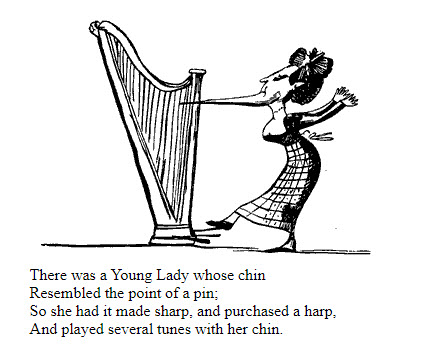Limericks are a fun form of poetic expression that have a five-line A-A-B-B-A rhyme scheme. The first, second, and fifth lines have a strong downbeat and rhyme. Lines three and four have five to seven (two metrical feet) syllables and also rhyme with each other. Limerick poems have an anapestic trimester, three metrical feet with two unstressed syllables followed by a stressed syllable.
Most of the limerick poems have a humorous or amusingly coarse or irreverent subject, and the first four lines set up the joke, and the last line delivers the punchline.

Rules for Writing Limerick
Limerick poems should have five lines with the rhythm AABBA, which is a pattern that determines the lines of the rhyme. A given letter of the alphabet represents the rhyming sound, the rhyme scheme begins with the letter A and uses a new letter for each ending sound. The form AABA indicates that the first and second and the fifth line should rhyme with each other. The third and the fourth line, on the other hand, form another pair of a rhyme scheme.
da DUM da da DUM da da DUM 7-10 syllables A
da DUM da da DUM da da DUM 7-10 syllables A
da DUM da da DUM 5-7 syllables B
da DUM da da DUM 5-7 syllables B
da DUM da da DUM da da DUM 7-10 syllables A
Each line of the limerick poem also has a specific number of feet and pairs of unstressed and stressed syllables. The first, subsequent, and last lines have three feet, while the third and fourth have two feet each. The poem thus has 9 or 8 syllables and 5 or 6 syllables, respectively.
Limerick poems are often funny, and share a point of view, even a negative point, through humor and wit while also following the rhyme scheme for which limerick poems are known. Irish people are generally the creators of more well-known limerick poems, as they celebrate and use that form of poetry often. Many limerick poems offer a humorous view into an aspect of life and existence, and because of this, they have become a favorite for many.
Origin and History of Limerick
Although the origin of the limerick poems is unknown, it is attributed to the 18th-century Irish soldier’s song. The soldier’s song was an impromptu verse which was crowded with improbable incident filled with subtle innuendo. The poem by the solder was titled, “Will You Come up To Limerick?’’ The first collection of English Limerick was recorded in 1820 by Edward Lear, and he claimed that he got the idea from a nursery rhyme.
The form of poetry started spreading in the 19th century, and by the 20th century, there were limerick concerts and competitions held by business houses and magazines in England. May other forms of the variation of the poem were adopted during that time, and some even adopted tongue twisters and Haiku poetry.
Other forms of the literature were adopted into different languages in the 19th century as well, the French and Latin versions of the limerick poems exploited the irregularities of the English spelling. Moreover, the poems were used as a tool to make pithy observations concerning severe philosophical concerns.
2 Famous Examples of Limerick
Edward Lear, who composed the book of nonsense, is the father of the English Limerick poems, and Lear made the limerick poems famous during his time. He said that he got the idea form a nursery rhyme and decided to make the rhyme into a nonsensical and fun poem .here is an example of Lear’s limerick collection.
There was an Old Man who supposed
that the street door was partially closed;
but some very large rats
Ate his coats and his hats,
while that futile Old Gentleman dozed.
Many people in the 19th century started indulging in limerick poems, and another author W.S Gilbert displayed his skills as a poet, and Arthur Sullivan later adopted an example of his poem into one of the songs in ‘The Sorcerer’ in the early 19th century.
My name is John Wellington Wells,
I’m a dealer in magic and spells,
in blessings and curses,
And ever-filled purses,
in prophecies, witches, and knells.
Famous Poets Who Wrote Limericks
Edward Lear, an English poet, is considered the father of limerick poems, through his poem "Literary Nonsense" he exploited this form of poetry. Although the limericks came earlier in the 18th century, Lear helped popularize the form of art. Moreover, he wrote most of the best limericks that have been preserved and passed down from one generation to another.
Many famed poets turned into nonsense poetry, another poem that wrote limerick poems was Lewis Carroll, who wrote the limerick “There Is a Young Lady of the Station.”
Related Terms
alba, anacreontic, balada, ballad, ballade, bucolic, canso, chanson, clerihew, dirge, dithyramb, eclogue, elegy, English sonnet, epic, epigram, epithalamium, epode, epopee, epopoeia, epos, georgic, ghazel, haiku, Horatian ode, idyll, Italian sonnet, jingl